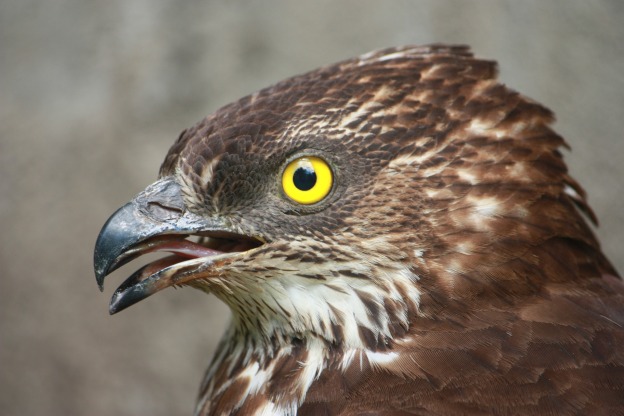
Photo by Noutch/Pixabay.com • Although its name might suggest otherwise, the honey buzzard isn’t looking to dip its beak in something sweet. These unusual raptors raid the hives of bees and wasps to feed on the larval form of these stinging insects.
It’s not all bird seed and suet cakes for many of our feathered friends. Some of the world’s nearly 10,000 species of birds show some unusual tastes when it comes to their food. Facebook friend Philip Laws, who resides in Limestone Cove in Unicoi, shared a photo recently of a European honey buzzard, a type of raptor that’s developed a knack for raiding the hives of bees and wasps. A comment on the post suggested that the buzzard had developed a taste for sweets.
Actually, the truth’s a bit stranger. While many of the hives attacked by the buzzard are loaded with sweet honey, this aberrant raptor’s more interested in the larval bees and wasps housed in the hive’s honeycomb nursery chambers. The honey buzzard, also known as a pern or common pern, is related to such carnivorous raptors as sharp-shinned hawks and rough-legged hawks.
If you’re worried about the so-called “murder hornets” in recent news articles, just know that the honey buzzard is the only predator known to feed on these insects. In fact, the honey buzzard takes great relish in dining on the larval forms of these wasps, which are more accurately known as Asian giant hornets. The honey buzzard’s head feathers are like scales, helping protect this vulnerable area from stings. In addition, some experts believe the buzzard’s feathers contain a chemical insect deterrent. This raptor also has long toes and claws it can use to dig into a hive.

Photo hbieser/Pixabay.com • The hoatzin, a bird native to South America, feeds almost exclusively on foliage, making it one of the few “grazers” among the world’s birds.
While many birds are seed-eaters, few of them have evolved as grazers and vegetarians. In South America, however, there’s a most unusual bird known as the hoatzin. Also known by such names as “reptile bird,” “stink bird,” “skunk bird” and “Canje pheasant,” the hoatzin lives in swamps and mangrove forests in the Amazon and Orinoco basins of South America.
One of the hoatzin’s claim to fame is that it’s a folivore, which simply means it eats foliage, or leaves, as well as fruit and flowers. The bird has even developed a special stomach called a “rumen,” that permits bacterial fermentation of the leaves it devours. Some studies indicate that as much as 80 percent of a hoatzin’s diet consists of leaves.
The great blue turaco is an African bird that, like most other members of the turaco family, eats mostly fruit, but this bird will eat leaves and even algae when fruit is scarce. Closer to home, the cedar waxwing’s a well-known fruit lover. Birds that eat mostly fruit are known as “frugivores.” A large flock of waxwings can make short work of the fruit of holly or mulberry trees. The berries they eat can even affect their appearance. Some waxwings show an orange, not yellow, tail tip. The orange coloration is the result of the birds eating honeysuckle berries with a red pigment.
Fans of French cuisine have probably sampled “escargot,” which is basically culinary snails. Of course, humans have a wide range of unusual tastes. There is a species of bird that specializes on feeding on snails, albeit without the garlic and butter of the traditional French dish. The snail kite is found in southern Florida, especially in the Everglades. This raptor feeds almost exclusively on apple snails and has even evolved a specialized hooked beak to help rip the snail from its protective shell.
Around the globe, various birds have evolved as “sanitation crews” for the ecosystems that they inhabit. Vultures in both the Old World and New World feed on carrion, although a few species will tackle living animals. On the African plains, different vultures have evolved to clean up the carcasses of large herbivores. Different ones have become quite familiar to fans of nature documentaries. These are the large vultures that quickly claim a carcass once lions and other predators have eaten their fill.

Photo by Pixabay.com • The lappet-faced vulture is a scavenging bird, feeding mostly from animal carcasses found in dry savannah habitats.
Some of the species include Egyptian vulture, Indian vulture, lappet-faced vulture and griffon vulture. Many of the Old World vultures are declining at alarming rates largely due to poisoning by insecticides and other chemicals. Their populations are crashing in a similar way to that of bald eagles, which were brought to the brink of extinction because of the use of the pesticide DDT in the 1950s an 1960s.
While I wouldn’t suggest we offer snails, salads or carrion at our feeders, the dietary habits of some of our birds just go to show what fascinating creatures birds truly are.



